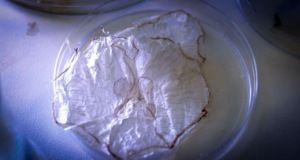News
So that’s three pints, a bag of nuts, and a packet of Portuguese Man of War crisps?
This article is more than 8 years old.
Jelly babies, jellied eels and now jellyfish potato crisps, thanks to new Danish research

They’re ugly: like a prawn cracker that has just got a tattoo (photo: sdu.dk)
Mie Thorborg Pedersen, a gastrophysicist from the University of Southern Denmark, has just published research that might well prompt the transformation of the jellyfish crisp from an Asian delicacy into a Danish staple consumed en masse.
A changing style
While the current Asian-style jellyfish tends to take on a rubbery texture when prepared, the method used by Pedersen and her fellow researchers produces a crisper, thinner product that could be complemented by different seasoning as found on more traditional crisps.
Furthermore, the methods of preparation across Asia tend to take a month using a mixture of kitchen salt and alum, whereas Pedersen and her team have found that drying the jellyfish in a 96 percent ethanol solution shortens the process to just a matter of days.
Good news for veggies
Pedersen also resolves some foreseeable vegetarian angst, regarding jellyfish as a ‘gel’ rather than an animal.
“It does not mean that I do not classify jellyfish as animals,” she told CPH POST. “But from the point of view of a physicist, it is more practical to consider the jellyfish as a gel.”
It is unclear what the implication of such approximations will be for potential food manufacturers in Denmark and beyond.
This is by no means the very first we’ve seen of the jellyfish crisp in the country. Danish chef Klavs Styrbæk has been experimenting with the delicacy for some time.
A healthy alternative?
Research published in the International Journal of Gastronomy and Food Science also notes how the jellyfish crisp is a much healthier alternative to traditional fried crisps.
A 25 gram potion of crispy jellyfish contains 0.5 g of fat, compared to the average 10.4 g in normal, ready salted crisps.
Jellyfish are also known to contain selenium, which is used as an anti-ageing agent.










































